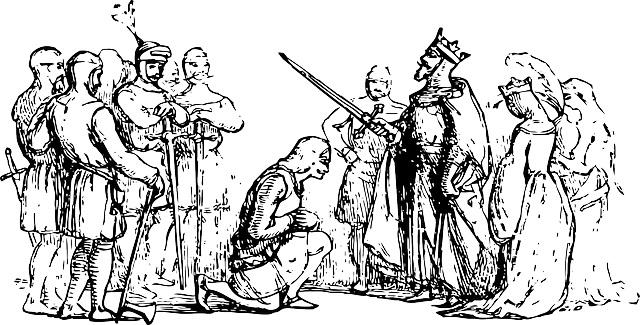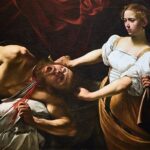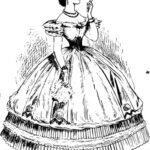
The legend of King Arthur is one of the most famous medieval stories ever known that still resonates even with contemporary audiences. Throughout history until the present day, numerous writers have published multiple versions of the Arthurian tale with their own characterizations, different scenes, and particular plot twists. Two such famed writers are Sir Thomas Malory with Le Morte Darthur from the late 15th century, and Alfred Tennyson with Idylls of the King from the 19th century. This essay will compare and contrast the two Arthurian works and will demonstrate how Tennyson dramatizes Arthur’s demise in a much more final and doleful manner, while Malory portrays Arthur’s death with less clarity and certitude.
The different approaches to the death of Arthur between Malory and Tennyson are revealed with Arthur’s own acknowledgment of his fatal state. In Le Morte Darthur, after Sir Bedwere finally complies with Arthur’s request to throw away his sword to the sea, Arthur tells him, “helpe me hens, for I drede me I have taryed over longe” (1240.10-1) – a dry statement without any regard to his deadly injury. Then, Sir Bedwere carries Arthur on his back and takes “hym to the watirs syde” without evincing any sort of emotion (1240.12-3).
In Idylls of the King, however, Arthur not only openly professes three times that he is likely to die, but Tennyson also portrays heart-rending scenes with Sir Bedivere. Arthur admits to Sir Bedivere that his “end draws nigh” (331) and that he “shall die” (334); after this admission and before Sir Bedivere carries him, Arthur “half” rises, “looking wistfully with wide blue eyes / As in a picture” (335-8) while Sir Bedivere watches him tearfully, wanting to speak “but he found not words” (338-40). Then, in no less than 17 lines (344-60), there is a sentimental description of how Sir Bedivere carries Arthur agonizingly, as Arthur again expresses his premonition that he “shall die” (348).
The contrast between the two works is clear: while Malory is quite succinct with the characters’ acknowledgment of Arthur’s fate and display of emotions, Tennyson embellishes this scene with poignant recognitions and manifestations of feelings, which add to the general sense of finality.
The scene by the lake perhaps demonstrates best how Tennyson enhances and adjusts Malory’s version to build up gradually the comprehension that Arthur will soon die. In Le Morte Darthur, in a mere couple of short sentences, Malory describes that Sir Bedwere and Arthur reach “a lytyll barge wyth many fayre ladyes” with “blak hoodis” who “wepte and shrieked whan they saw kynge Arthur” (1240.14-7). In comparison, in Idylls of the King, there are more detailed echoes of death about the “Dark as a funereal” barge (363), the “[b]lack-stoled, black-hoodded” Queens (366-7), and their “cry,” “agony,” “lamentation,” and more grim similes that emphasize their anguish (368-72). In both works, Arthur tells Sir Bedwere Thereafter to put him in the barge. In Le Morte Darthur, Arthur then “layde hys hede” in one of the ladies’ laps (1240.21-2); in Idylls of the King, however, Tennyson makes Arthur more passive and frail by depicting one of the Queens laying Arthur’s “head upon her lap” (376), and then attentively treating him while crying over his bloody brow (377-380).
If so, the scene near the lake can illustrate accurately how the two writers handle the final moments of Arthur in the text: Malory remains relatively concise with his descriptions, while Tennyson enlarges them with emotions, lamentations, gestures and images that gradually impart the notion that weak Arthur is about to perish.
Similarly, the scene of the last conversation between Arthur and Sir Bedwere is more melodramatic and longer in Idylls of the King than in Le Morte Darthur, which conveys much more the sense of ending. Malory depicts a very short dialogue between them in which Sir Bedwere bemoans questioningly what would he do without Arthur (1240.29-30), and then Arthur tries to console him and subsequently asks him to pray for his soul if he does not hear from him again (1240.31-5). In Idylls of the King, Tennyson borrows the exact same sentiments of the conversation from Malory’s Le Morte Darthur and turns them into a prolonged effusive exchange. Sir Bedivere gushes extensively about his and King Arthur’s time together and about his own lonely future after Arthur will be gone shortly (394-406); then, Arthur lengthily soothes Sir Bedivere by explaining that everything is God’s will by elaborating on the values of prayer and by describing in detail his final destination, Avilion (407-32).
After the last exchange of Sir Bedwere and Arthur in Le Morte Darthur, Malory briefly describes how “the queen and ladyes wepte and shrieked,” and how Sir Bedwere then loses sight of the barge and also “wepte and wayled” until he finally leaves to the forest (1241.1-4). In comparison, Tennyson in Idylls of the King intensifies the sentiments in this part of the scene as well by likening the barge with the wailing Queens to a “full-breasted swan / That, fluting a wild carol ere her death” – clearly an ominous simile – while Sir Bedivere looks at it sailing away until it disappears and “the wailing die[s] away” (433-40). Tennyson, however, does not end the scene there like Malory but also adds more signs of finality: Sir Bedivere remains to stand, amazed by the “stillness of the dead world’s winter dawn,” and then he remarks, “The King is gone … From the great deep to the great deep he goes” (442-5) – comments that reaffirm Arthur’s passing.
The entire scene that surrounds the last conversation between Arthur and Sir Bedivere in Idylls of the King is therefore essentially an augmented version with more emotionality and theatricality of the same brief conversation in Le Morte Darthur, which thus distinctly creates an atmosphere of ultimate concluding valediction.
In spite of the differences mentioned above between the two works by this point, both texts still revolve around the same events; however, in the subsequent scene, there is a complete deviation between Malory’s Le Morte Darthur and Tennyson’s Idylls of the King, which leaves a different final tone concerning the passing of Arthur.
In Le Morte Darthur, Sir Bedwere reaches a chapel where he meets a hermit who tells him that several ladies brought him a corpse the night before for burial, and Sir Bedwere concludes that this is Arthur; yet, the narrator repeats multiple times that he is not certain if that was indeed Arthur and thus leaves the tale open. The narrator claims that “nothir more of the very sertaynte of [King Arthur’s] dethe harde I never rede” (1242.4-5). Then again, he states that “more of the deth of kynge Arthur coude I never fynde” (1242.15-16) and that the “ermyte knew nat in sertayne that he was verily the body of kynge Arthur” (1242.19-20). Additionally, the narrator later adds that “som men say in many partys of Inglonde that kynge Arthure ys nat ded … and men say that he shall com agayne” (1242.22-5); finally, the narrator says that “many men say” that on Arthur’s tomb, there is an inscription that translates into, “Here lies Arthur, king once, king to be” (1242.27-9 / Cooper, 1998: 517).
In Idylls of the King, the ending is much more definite and conclusive. Tennyson completely omits the entire scene with the hermit and instead follows the footsteps of Sir Bedivere, who laments and cries that Arthur “passes to be King among the dead” until he might return from the dead “after healing” (449-451). He follows a speck in the distance, which he believes to be the barge, until it “vanish[es] into light” (465-8). Some critics argue that Sir Bedivere merely clings to “the faint hope of [Arthur] returning to a kingdom that never was” after his and all other characters’ idealisms and belief in Arthur’s authority and reality collapse (Rosenberg, 1987: 144), which perfectly aligns with Tennyson’s attitude to Arthur’s presumed passing. Tennyson hence ends “The Passing of Arthur” with far more certainty regarding Arthur’s death than Malory, who insinuates that Arthur might not have died at all.
In their respective Arthurian works, Malory and Tennyson handle the passing of Arthur differently. Malory portrays the events in a relatively dry and terse manner, and leaves the possibility that Arthur did not die much more open. Tennyson, on the other hand, adds to the text more emotions, sentiments and acceptance that ultimately establish a sense of finality of Arthur and the Arthurian civilization. While the passing of Arthur in Le Morte Darthur contributes to the mythicization of King Arthur with an unclosed ending, Idylls of the King contributes to the aggrandizement of the Arthurian world that finally comes to an end. Both texts are instrumental to the immortalization of the Arthurian legend, at least until he shall com agayne.
Works Cited
Rosenberg, John D. “Tennyson and the Passing of Arthur.” Victorian Poetry 25.3/4. 1987. pp. 141-150.
Malory, Thomas. Le Morte D’Arthur: The Winchester Manuscript, ed. Helen Cooper. 1998.
Malory, Thomas. Le Morte D’Arthur from The Works of Sir Thomas Malory, ed. Eugene Vinaver, 3rd ed., rev. P. J. C. Field, 3 vols. 1990. III, 1240-42.
Rosenberg, John D. “Tennyson and the Passing of Arthur.” Victorian Poetry 25.3/4. 1987. pp. 141-150.
Tennyson, Alfred. Idylls of the King, ed. J. M. Gray. 1989.



